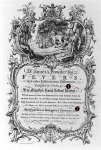
The Everlasting Club
London has long been famous for its Gentlemen’s clubs – not the dens of iniquity where you can see scantily clad young ladies like Spearmint Rhino and Claridge’s – but rather the more staid establishments where gentlemen (and, nowadays, to the regret of some, women) can meet to wine and dine. Naturally, certain clubs attract a clientele which shares the same range of tastes, opinions, habits and eccentricities.
It seems that the formal meeting of groups as Clubs owes its origin, in England at least, to the 17th century. Samuel Pepys, to whom we are indebted for our understanding of everyday life, writes in July 1660, “Went to Wood’s, our old house, for clubbing.”
It was the following century that clubs really established themselves and one that would have been fun to be a member of, although perhaps injurious to your long-term health and well-being, was the Everlasting Club. It had a membership of one hundred and it gained its name because it sat day and night without interruption, year upon year.
The upside, of course, was that irrespective of when you chose to visit the establishment at the crack of dawn, midnight, lunchtime or tea time – you would be guaranteed to find someone there with whom to spend the time of day (or night), smoke a pipe and drink an alcoholic beverage. The downside, of course, was that if your companions deserted you, you were obliged to stay in situ until the next member arrived.
A cherished tradition was that the Steward never died. His pride of place, a great elbow-chair at the head of the table, was not vacated by the present incumbent until such time as his successor was ready to take possession of it. Similarly, the fire never went out. The club employed an old woman, known as a Vestal, whose duty was to look after and perpetuate the fire which is said to have burnt from generation to generation. The fire also served to light the members’ pipes and to keep dampness at bay.
The members entertained themselves with talk – they were contemptuous of all other clubs – reminiscences of members past, particularly those who had never stirred from the club’s premises for weeks on end, card games, song and pipe smoking. By 1702 so prodigious had been their intake that the club’s accounts that since the turn of the century they had smoked fifty tons of tobacco, had drunk thirty thousand butts of ale, one thousand hogsheads of red port, two hundred barrels of brandy and one measly kilderkin (about 81 litres) of small beer.
The club met ensemble four times a year to transact its business such as electing members to fill vacancies, appoint waiters, re-appoint or appoint the fire maker and settle contributions for club necessities such as coal, pipes, tobacco and hooch.
The origins of the club are lost in the mists of time but it is thought that the first meetings were held during the Civil War. The club’s premises were threatened by the Great Fire of 1666 but the then steward showing the presence of a truly pickled mind refused to leave and was only persuaded to do so after he had emptied all the bottles on the table.
Some club!




